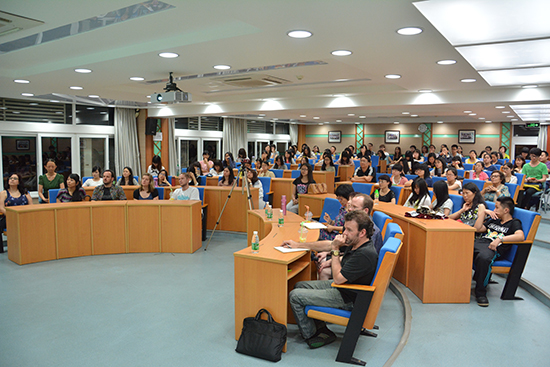For a long time, "Made in Italy has been a guarantee of good quality" and, according to a survey made by KPMG, "Made in Italy" has become one of the most recognizable brands in the world, next to Coca-cola and Visa. The products made in Italy have been favored by customers all around the world for their high quality and artistic design, however, few people know how the culture and tradition of Italy influence the making of these products.
On the evening of May 22nd , a presentation with the theme "What Does Made in Italy Really Mean?" was held in the MBA teaching building. The presentation, as the second event of Foreign Expert's Forum, was organized jointly by the Department of International Exchange and Cooperation and Faculty of Western Language and Culture.
After the enthusiastic introduction by the hostess Ms. YU Tingting. the speaker, Professor Matteo Brandi from Italy, went onstage to begin his presentation. Introducing the theme to the audience, he showed the audience the underlying cultural and social reasons for the high quality Italian products.

Professor Matteo Brandi introducing history of the Italian fashion
At first, Professor Brandi talked about the cultural background in Italy. Italy, at one point in history, was center of the classical world and has striking achievements in architecture, sculpture and painting. Despite its splendor in culture and arts, noted Professor Brandi, Italy was a country with a political weakness, and had been invaded by many countries throughout history. However, it was this very political weakness that resulted in the great variety and difference of culture and arts in Italy to that of the rest of the world. And this cultural variety, and the classic art elements, can be found in the design of many Italian brands such as Versace and Gucci.
Next in his presentation, Professor Brandi pointed out the central role of craftsmen in Italian history. He also introduced the concept of Bottega which emerged in Italy during 11th and 12th centuries, which are indispensable factors making the development and recognition of the high quality of Italian products.
During the Golden Era between 12th to the 16th centuries, and with the increasing trade with other countries in the world, the large quantity of imported products also influenced the art of Italy, that is by way of explaining why there are so many exotic elements from other nations present in Italian products.
In the last part of his presentation, Professor Brandi led us through the industrial production era, illustrating how industrial production in Italy started late, after the WWII, and is characterized by a strong relationship with the USA. During this time , small and medium-sized enterprises and family controlled enterprises began to produce goods of high quality, establishing the strengths of 鉳ade in Italy ?as a brand.
The presentation ended with a wonderful video chip showing the magical process of an Italian craftsman making a glass horse. The superb skill of the craftsman amazed the audience and made them cry out in excitement.
In the Q&A session following, many interesting question were raised by both American and Chinese students, questions such as whether craftsmanship is still valued in Italy and the others regarding the similarities between Chinese and Italian craftsmanship.

Audience listening carefully

Q&A Session
Professor Brandi's presentation captured the attention of the audience on a numbers of levels: what exactly is craftsmanship? How can this distinguish the work of artisans in different countries, attracting people to buy their goods? What are the quality criteria of a brand and other points. All in all, a totally worthwhile evening.

